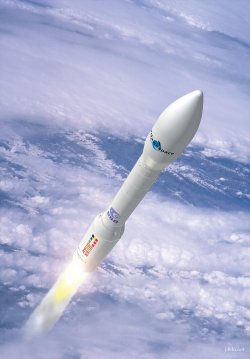The Zefiro 9 third stage of the European Space Agency’s new Vega small launch vehicle, designed to carry 1.5t to low-Earth orbit, was successfully test fired for the first time on 19 December.
 The 10t Zefiro 9 is a 3.5m (11.4ft)-long, 1.9m-diameter, solid-rocket motor made by Italian propulsion company Avio. At 217s into a launch it will ignite above 328,000ft (100,000m) and propel the launcher’s fourth stage into a suborbital trajectory at 1.3 million ft/s (7,000m/s).
The 10t Zefiro 9 is a 3.5m (11.4ft)-long, 1.9m-diameter, solid-rocket motor made by Italian propulsion company Avio. At 217s into a launch it will ignite above 328,000ft (100,000m) and propel the launcher’s fourth stage into a suborbital trajectory at 1.3 million ft/s (7,000m/s).
The sea-level ground firing test on Italian ministry of defence land in Salto di Quirra, Sardinia followed a normal mission profile, lasting for 116s. “The preliminary tests results are in accordance with the predictions. Everything went well, we are satisfied with the outcome,” says Avio’s Vega programme chief Pierluigi Pirrelli.
To accommodate the different ambient atmospheric pressure at sea level, compared with its 328,000ft-plus operating altitude, the motor’s carbon-carbon nozzle was shortened so it could cope with the different expansion needs of the exhaust.
The nozzle has thrust vectoring using two actuators for pitch and yaw control during flight. Its design is based on the Vega’s Zefiro 23 second stage, which will be tested in the middle of this year at the same location. Test firing of Vega’s P80 first stage will be in Kourou, French Guiana, at the Vega launch site later this year.
The four-stage Vega will launch single and multiple payloads of up to 1.5t to circular orbits of 300-1,500km (190-930 miles) at inclinations of 5° to 100° for €20 million ($24 million) from 2008.
Source: Flight International


























